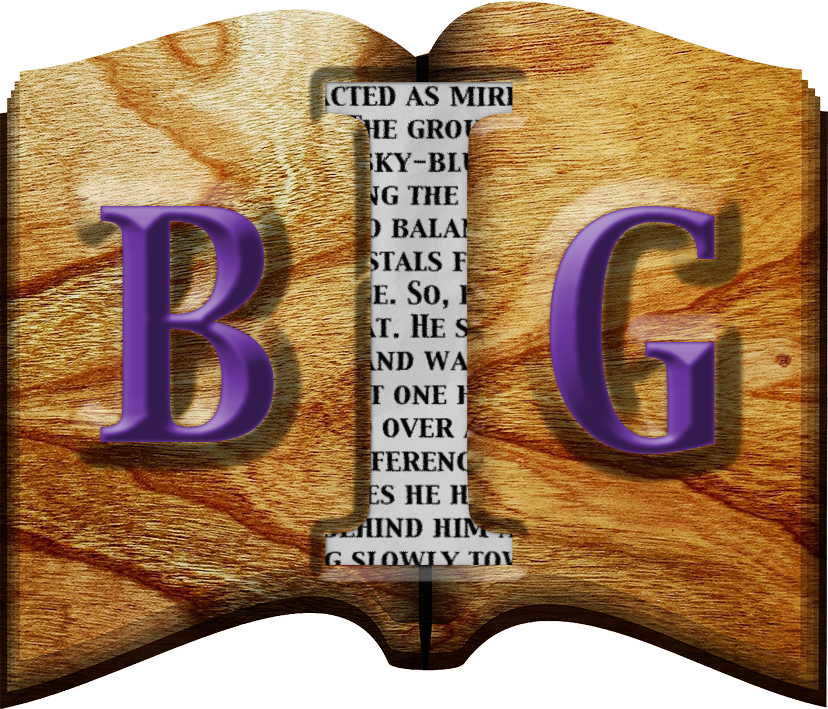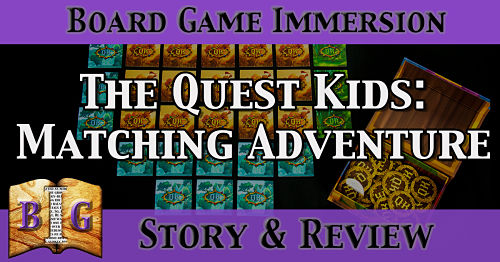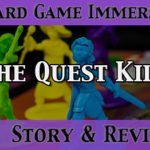At a Glance: The Quest Kids: Matching Adventure
Designer: Dustin McMillian
Publisher: Treasure Falls Games
Artist: Apolline Etienne
Player Count: 1-6
Suggested Age: 3+
Playing Time: 20 minutes
Theme: Fantasy, Children
Mechanics: Matching, Memory
Find more about The Quest Kids: Matching Adventure by visiting Treasure Falls Games online on Facebook and Instagram, and purchase the game on their website!
“Congratulations!
Today is your day.
You’re off to Great Places!
You’re off and away!”
― Dr. Seuss, Oh, the Places You’ll Go!
Intro Story: Bad Guys Lurking
Noah rushes into the treehouse, panting. “Bad guys! In the forest and near the river!”
Ivy, Skylar, and Crash look at each other, concern showing in their eyes. “What should we do?” Crash asks.
“We’re Quest Kids,” Skylar replies. “We need to do something.”
“They’ll be hiding, waiting for us,” says Ivy. “So we’ll have to be sneaky.”
The heroes rush out the door, creating their plan as they go. “Remember,” Noah says, “it’s gotta be convincing, otherwise it won’t work. See you back at the treehouse!” At the fork, Skylar and Crash head to the forest and Ivy and Noah head to the river.
At the river, Noah and Ivy sneak past tall trees and wide bushes. Soon, they hear a rustling up ahead. Ivy puts her finger to her lips, signaling Mason to not make a sound. Together, they circle around and approach the source of the noise from behind. Ivy counts down with her fingers: 3, 2, 1…
Noah and Ivy roar loudly, and the pirate hiding in the bushes jumps up and runs away, screaming for his mother. Mason and Ivy giggle softly as the pirate flees. But there are more noises ahead, so their laughter is quickly quieted. Following the same plan, they continue sneaking up on the bad guys and scaring them away. After scaring a dragon, which flies away in a fright, they look down on two pieces of treasure the dragon left behind. They each take one and continue clearing the area of bad guys.
Once all the bad guys are gone, Ivy and Noah head back to the treehouse to wait for Skylar and Crash. When the other two arrive, they all show off the treasure they found from scaring off the bad guys. Crash comes back with seven pieces, Skylar has eight, and Noah has eight as well. Ivy, however, has nine pieces of treasure. The group of young adventurers congratulate Ivy on finding so much, and together they talk about their adventures until it gets dark.
When their parents call them to come in for bed, the heroes promptly return home, eager to show off their treasure to their families and ready for dreams filled with even more adventures.
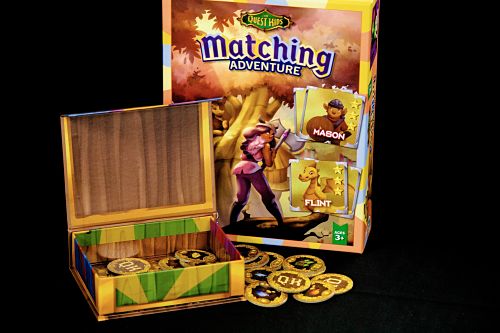
Note: I was provided a complimentary copy of The Quest Kids: Matching Adventure for the purpose of review. The thoughts and opinions in this review are my own.
Overview/Roadmap
This review has two parts. First, there is the Short Review, where various aspects of the game are discussed. Then comes the Gameplay Review, in which the setup and gameplay are discussed in detail, along with initial thoughts. Following the Gameplay Review section are some final thoughts and a final verdict of the game. Feel free to jump around, or read it all in one go.
About My Kids
The Quest Kids: Matching Adventure is geared toward young children (ages 3+), so it’s important you know a little bit about my kid in order to know if this game might work for your little ones.
I have three children, two of which are old enough to play this. The boys, ages 4 and 5 (6 in a few months, as of this writing), love games. My oldest plays anything from Guess Who to My Little Scythe to Forbidden Island to Herbaceous to anything we’ll let him play, really. He lives and breathes games, and he will play them as often as he can. My four-year-old, however, struggles to finish games that are too involved. He enjoys My First Orchard, Crokinole (and he is very good at it), My First Castle Panic, and other games where there are few rules.
I was interested, then, to see how appealing The Quest Kids: Matching Adventure would be to a kid who will do anything to play a game, and to one who really struggles to find games engaging. Spoilers: I was pleasantly surprised on both sides of the spectrum.
Short Review

The Quest Kids: Matching Adventure is a memory and matching game targeted for young children, ages 3 and up. It’s fantasy based and has special abilities and fun rules to get kids engaged and involved. It gets my 4-year-old excited and engaged throughout the entire game, which is a big win on my books.
As the following review is for a game targeted to young children, my opinions will be focused on their opinions, and the overall rating and enjoyment of the game will come from their thoughts, from both post-play discussions and my own observations as we played.
Immersion
My oldest always, always asks if a game has bad guys in it. Somehow, he is mildly obsessed about defeating bad guys. Needless to say, he was beyond thrilled to learn that The Quest Kids: Matching Adventure does indeed contain bad guys. His sole purpose was to find the bad guys to defeat them. In other words, he was totally into it. My four-year-old was just as excited to find the bad guys and defeat them. As far as getting my kids immersed, this game did a good job of it.
Theme
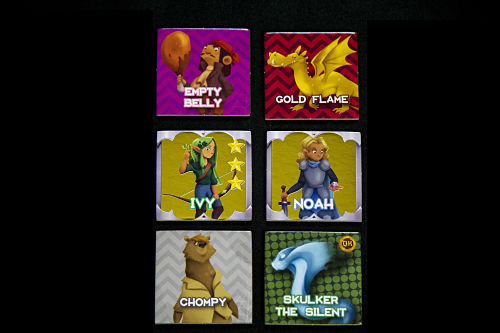
The fantasy theme of wizards, trolls, dragons, and other genre-specific creatures and characters is one I, personally, am a fan of, and one that really gets my oldest excited. He has a mild freak out every time he comes across a dragon or scary-looking bad guy. Plus, I think it’s fun to get my kids more immersed in fantasy lore and world building at a young age. It’s a fun theme, and one kids (at least my kids) love to play with.
Components
The components consist of cardboard tiles, cardboard treasure tokens, and a cardboard treasure box (included in the Kickstarter version) in which the treasure tokens are kept. I love the treasure chest, as it adds a fun, thematic element when gaining treasure. All of the game pieces are sturdy and appear to be able to stand up to the regular abuse young kids can sometimes give to a game.
Standout Performances
- Treasure chest
- Fun theme
- Age-appropriate mechanics and characters/creatures
- A new take on matching games
Breaking the 4th Wall
In theater, breaking the fourth wall refers to when characters (or something else) directly address the audience, thus pulling them out of the narrative and making the astutely aware that they are, in fact, watching a performance and that’s it’s not actually real.
There really isn’t anything “bad” about this game. It’s age appropriate and does its job in a wonderful manner. The only thing I can see being an issue is having the kids set up the game. There are pictures to aid with setup, which my oldest should be able to follow, but explaining to younger kids how to set up the treehouse tiles, river tiles, and forest tiles may be asking a bit too much.
Of course, a lot of times we as parents play with our kids, so setting up won’t be an issue in that case. But my kids do enjoy playing games on their own, and having my kids able to set up a game by themselves can be a real life saver if I’m, say, in the middle of making dinner and can’t help lest I burn the victuals.
All in all, though, setup takes little time, so even if they can’t do it themselves, it won’t take me long to do it and they can play just fine on their own.
The Quest Kids: Matching Adventure Gameplay Review
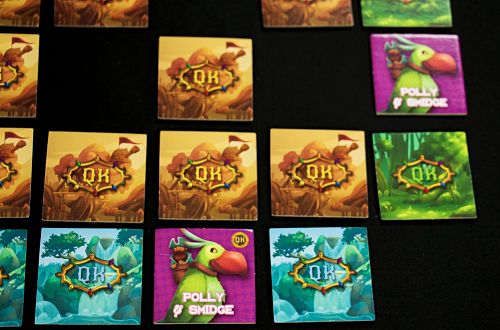
First Impressions
Upon first bringing out The Quest Kids: Matching Adventure, my two oldest boys couldn’t stop looking at the tiles and treasure tokens, not to mention opening and closing the treasure box. I found setup to be a breeze, and the first game I played with my four-year-old, he did insanely well and had a great time. He laughed, he gasped, and he was really into it. I excluded my five-year-old for the first game because he can be overbearing when playing games, and I wanted my four-year-old to get a chance to play without any outside influence.
Playing with both my four- and five-year-old proved to be a good experience anyway. Both of them laughed and loved it, and subsequent plays were no different.
Setup
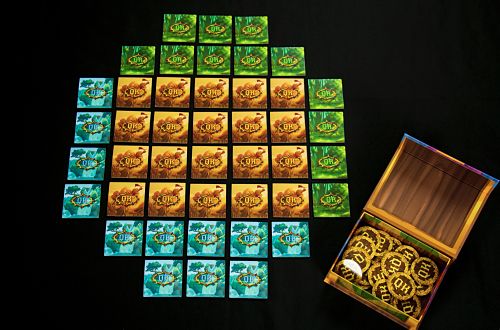
Setup is a cinch (if you, the adult, is setting it up). Simply randomize the treehouse tiles and arrange them in a 4×5 grid, then arrange the river and forest tiles according to the setup instructions. Select the number of bad guy groups you want to play with, which will determine the length of the game. It’s an easy setup, but if you want your kids to be able to set it up on their own, you may have to go over it with them a few times until they understand what a “bad guy group” is, or how to arrange the tiles. But it’s easy enough that they’ll be able to figure it out after enough run-throughs.
Gameplay

Players take turns flipping over tiles, trying to get a match. Before you can start finding bad guys, you need to match a hero from the treehouse. When flipping over treehouse tiles, two are flipped over. If you flip over two of the same heroes, you take both tiles and put them in front of you. If you reveal two of the same allies, you take the one with the stars on it, and you give the matching (starless) ally to another player. These allies have special abilities that can help you during the game. There are words on them, so you may have to help your kids read what they do. You may not have more than one hero pair until all players have found a hero. Then it’s a free-for-all. If you don’t get a match when revealing, flip them back over so they are once again hidden.
Once you have a hero, you can start hunting bad guys. When hunting bad guys, flip over three tiles. Because each bad guy has a tile in the forest and river sections, you’ll want to flip over one in each location. For your third flip, you can flip any tile from those two regions. Technically, you can flip all three from one region, but you won’t find any matches that way. If you don’t get a match, flip the tiles back over. If you do find a match, take the tiles and place them in front of you.
Each bad guy tile gives you one or two pieces of treasure (depending on the number of “QK” symbols on the tile). After scaring away a bad guy, draw one or two treasure tokens and add them to your collection of goodies. The star value at the top of the treasure token indicates how many points you get from that token at the end of the game. However, if you matched a hero that also matches the hero shown on the bottom of the treasure token, you get that many stars instead. Because stars equal points, you want to find the most treasure, heroes, and allies to ensure you win the game. Once all tiles are matched, the game ends and scores are tallied. The player with the highest total wins!
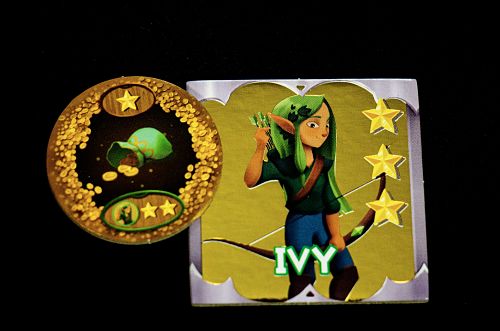
Thoughts on Gameplay
The Quest Kids: Matching Adventure is a simple game, but still maintains the appeal kids are looking for in an adventure. It’s a wonderful game that helps kids with their memory, and adds just a little bit more that helps introduce young children to games with more rules. Turns are quick, and even though it’s targeted to a young crowd, I still enjoyed the games I played with my kids. It’s a fun game, and perfectly executes what it sets out to do, which is give young kids the chance to participate in a fantastic adventure.
Solo Play
The player count of this game includes solo play. That said, there aren’t any rules for making it a competition. Sure, kids can play by themselves—and this would be a fun option for kids who don’t like the winner/loser aspect of games—but if they’re looking for some sort of goal to achieve (i.e. winning), then playing with others will be their best option.
Final Thoughts on The Quest Kids: Matching Adventure

I have nothing but good things to say about The Quest Kids: Matching Adventure. The game plays quickly, it’s easy to learn (even for young kids), and is engaging. It’s a wonderful game for young kids (ages 3+, according to the box). My five-year-old really likes it, and my four-year-old played it multiple times in a row without getting board—which is actually quite impressive for him!
When asked if he liked the game, my four-year-old said, “It’s pretty fun.” When I followed up with why he thought it was “pretty fun,” he said, “It’s fun to destroy monsters.” (Someone needs to tell him we’re just scaring them away, but if it works for him, it works for me.) I also asked my five-year-old what he thought of the game, and he said, with all the excitement only a five-year-old can muster, “Oh, it was wonderful!”
Final Verdict
I am so happy to see a game created for level-three children and above (i.e. ages 3+) that doesn’t involve Candy Land-style mechanics and that subtly introduces an extra rule or two into an otherwise generic matching game. But the theme makes it unique and fun, and with all things combined, it’s a solid game for kids. For what it is, my kids still found it captivating, although my five-year-old was perhaps a little less enamored than my four-year-old. That said, it was still very fun for my oldest, so considering their excitement while playing and based on their reactions while playing, Captivating is my final verdict, for The Quest Kids: Matching Adventure.
Verdict Scale (Lowest to Highest)
The Final Verdict is based on a scale of 1-7, although this scale is not numbered. Instead, it uses thematically appropriate words to describe the performance of the game.
Tomatoes – This game was emotionally taxing and difficult to finish.
Uninspiring – This game had me daydreaming about other games.
Lackluster – This game had its moments, but it probably won’t see much table time.
Laodicean – This game is decent. It works. There’s a reason people like it.
Two Thumbs Up – This game is very good.
Captivating – This game is outstanding! It’s more than good; it’s practically a staple.
Standing Ovation – This is the best game you will ever play. Period.
Read short fiction inspired by board games at BGI’s stories page!
Find more about The Quest Kids: Matching Adventure by visiting Treasure Falls Games online on Facebook, Instagram, and purchase the game on their website!
